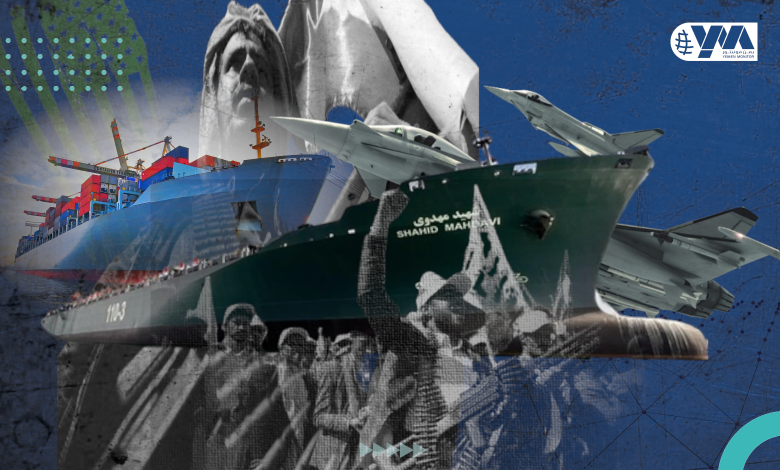Iranian Drone Carrier Deployment: Is it Linked to Houthi Operations? (Exclusive Analysis)

Yemen Monitor/Reports Unit/Exclusive Analysis:
An Iranian warship has embarked on a mission in ocean waters after the Houthi armed group announced the start of the fourth phase of naval operations that began last November, according to Iranian state media.
The semi-official Fars News Agency reported that the Shahid Mahdavi aircraft carrier, operated by the Iranian Revolutionary Guard Corps, has reached waters in the Southern Hemisphere, although the exact location was not specified.
The Iranian deployment itself is a significant milestone as it represents the first deployment of an Iranian ship below the equator and the first deployment of this type of ship in the waters of the Southern Hemisphere, which consists of the Southern Ocean, the Indian Ocean, half of the Pacific Ocean, and half of the Atlantic Ocean. It starts in the Indian Ocean off the coast of Yemen south of the Somali capital Mogadishu.
Iran had last April recalled warships and intelligence ships from the Red Sea and the Gulf of Aden, including the ship “Bahshad”, which is believed to have been providing the Houthis with information on targeting ships.
So, what will this aircraft carrier do in the Houthi battle?
What is “Shahid Mahdavi”?
Iran announced the “Shahid Mahdavi” drone carrier in early 2023. It is originally an old container ship that has been converted into a warship that can carry fixed-wing drones and helicopters. It also carries missiles, anti-aircraft weapons, and advanced radars. This greatly enhances the ability of the Revolutionary Guard to carry out medium and long-range strikes. It can carry a large number of drones that have been produced by Iran and used by the Houthis over the past years.
This ship has a variety of advanced radars such as the 3D radar, missile systems, surface-to-surface, surface-to-air, the Khordad-3 system, and other advanced communication systems, and is considered one of the state-owned ships.
In addition, the Shahid Mahdavi is the first Iranian ship equipped with long-range ballistic missiles.
According to General Alireza Tangsiri, Commander of the Navy of the Iranian Revolutionary Guard, in addition to long-range ballistic missiles, “Qadar 474” cruise missiles with a range of 2000 kilometers have also been installed on this ship.
The Revolutionary Guard has expanded its mission from the Arabian Gulf and the Strait of Hormuz to the Red Sea, the Gulf of Aden, and the Indian Ocean in recent years, so it has many warships deployed under its disposal.
Intelligence and Arms Smuggling
Iran’s dispatch of its first drone aircraft carrier to the high seas is deemed a significant development, showcasing Tehran’s exceptional capabilities in unconventional naval warfare, which it has utilized in the Houthis’ attacks in the Red Sea.
In this context, the following factors have an impact on Yemen and the security of the Arabian Peninsula:
First: After the departure of the ship “Behshad” from the Red Sea following last month’s Iranian/Israeli escalation, the Houthis require a source of intelligence information to target ships. Most international vessels traverse the high seas to reach their destination. Therefore, the advanced capabilities of the drone aircraft carrier can potentially provide a new source of information for the Houthis to target ships.
Second: Iran’s expedited development and use of explosive-laden drone aircraft from aboard carriers transported through waters accelerate the threats posed by Tehran to maritime security in the Red Sea and the Arabian Gulf.
The presence of a drone aircraft carrier threatens the commercial security of the Gulf Cooperation Council countries that export oil through the high seas. Iran has long relied on asymmetrical warfare by harassing commercial ships in strategic maritime chokepoints near it as a strategy to threaten neighboring countries, as observed off the coast of the Emirati shores in 2022.
Third: The possibility of Iran sending a drone aircraft carrier near the region to supply its allies like the Houthis cannot be ruled out, to evade the monitoring of transportation routes from Iranian ports to Yemen passing through third-party ports or transferred by sea.
The presence of a drone aircraft carrier at sea provides better opportunities for arms transfers to the Houthis, especially after the United States and the European Union have enhanced monitoring of the Yemeni coasts and nearby ports.
Fourth: The Revolutionary Guard’s reinforcement and presence in remote waters and the enhancement of both preemptive and retaliatory targeting capabilities following the exchanges of strikes with Israel last month rely on drone aircraft and proxies in the region.
Drone aircraft carriers facilitate Iran’s objectives of retaliation and preemptive strikes, not only against Western adversaries as nuclear deal negotiations grow more complex but also against regional rivals affecting their trade.
Over the past decade and a half, Iran has increased its naval power budget and allocated substantial resources to strengthen the Revolutionary Guard’s capabilities in drone aircraft, ballistic missiles, and their transfer to its proxies in the region, including the Houthis. The presence of a drone aircraft carrier represents a larger capacity for Iran to consolidate itself as a regional power supporting its proxies in maritime corridors.




